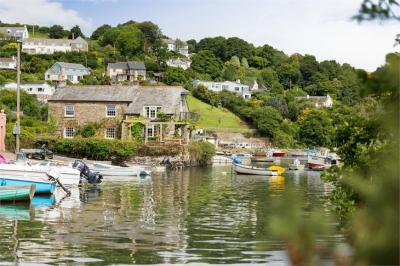


Peaceful riverside village
Web: www.golant.net
Golant is a small village on the west bank of the Fowey Estuary, about two miles north of Fowey and devoted to boats, fishing and peace and quiet. Some of the famous Troy boats are built here. The village is approached from the B3269 road from Lostwithiel. The population of the village was 230 at the 2011 census.
The village was once famed for its cider orchards, remnants of which can still be seen here and there, and today supports two thriving vineyards. The old Lostwithiel to Fowey railway runs alongside the river all the way but is now a goods line only, serving the china clay docks at Fowey.
Golant railway station was situated beside the river south of the village. It was served by trains on the Great Western Railway's Fowey branch line from 1st July 1896 until 4th January 1965. The station has been demolished and the site is now a car park. Par is now Golant's nearest railway station.
It has two historical connections that make it unique, that of The Life of St. Sampson and the story of Tristan and Iseult. The latter has many variations, one of which, goes as follows:
Tristan was a nephew of King Mark of Cornwall who was based at Castle Dore, and Iseult was an Irish princess betrothed to King Mark. Because of the hazards of travel in the 6th century Tristan was sent by his uncle to fetch Iseult. On the journey back from Ireland to Castle Dore she and Tristan fell in love and, inevitably, the human triangle was upset by the discovery of the lovers in compromising circumstances. Tristan fled to France where he was received with respect and he married the daughter of a local chief, another Iseult, but could not forget his first love. Wounded while hunting he became seriously ill, and sent a ship to Cornwall with a message for Iseult to come to France to nurse him back to health. He instructed his sailors to hoist black sails if their journey had been in vain, and white if she was aboard. His wife, discovering the plan, reported to Tristan that the sails were black whereas in fact they were white. Tristan died and, when Iseult arrived she too died and was buried beside her lover. Out of the graves grew two saplings, the branches of which became intertwined and it is said that 'in death they were united although parted in life'.
The link with the church of St. Sampson is that King Mark and Iseult made their devotions in state here, and that Iseult gave her best dress to the church. St. Sampson's life is one of the earliest recorded. He is known to have studied near Howth in County Dublin and later travelled to Wales and then to Cornwall where he established himself where the church now stands, having erected a shelter near the Holy Well which can be seen by the South Door. When he left Golant he went on to Brittany where he became Archbishop of Dol. The church is of traditional Celtic design and some parts are said to date from 1200. The present building was consecrated in 1509 and a restoration took place in 1842. There are five bells in the tower - the tenor dated 1807 weighs six cwt. There is interesting stained glass and much wood carving in the church.
A once well-used ford crossed the river near Golant. During the English Civil War in 1644 a 10,000-strong parliamentary army fought Royalist forces in area. King Charles was in the area during the campaign. The Earl of Essex and other prominent parliamentarians escaped by boat to Plymouth. Many 17th century cannonballs and musket balls have been found in the area.
The Sawmills recording studio on the river bank was established in 1974. The main building is a 17th century water mill and the site has a documented history stretching back to the 11th century. The studio was featured in the BBC programme 'Three Men in More Than One Boat' starring Rory McGrath, Griff Rhys Jones and Dara Ó Briain shown in January 2009. Little recording takes place at Sawmills nowadays and the building is principally a holiday let.
Outside the village on the road up to Castle Dore is Trenython Manor built in 1872 by an Italian architect commissioned by the famous General Garibaldi. It became the bishop's palace for the Diocese of Truro and lasted in this role for fifteen years. For half of the 20th century it was a railway convalescent home. Today Trenython Manor is a country house hotel.
The village is on the Saints' Way long-distance footpath.
Annabel Vernon (1982-), the Olympic rower, was a member of Castle Dore Rowing Club in Golant.
Charles I of England (1600-1649), who camped at Castle Dore "on the night before the surrender of the Parliamentary army in 1644" according to Arthur Mee.
Giuseppe Garibaldi (1807–1882), who lodged with Colonel Peard for some time after the gaining of Italian independence; Peard had fought in the campaign and was known as "Garibaldi's Englishman".
Francis Oats (1848–1918) was a Cornish miner who became chairman of De Beers diamond company in South Africa was born in Golant.
Golant Beer Festival - Third week in May.
Golant Carnival - Mid August.
Castle Dore Fowey Lostwithiel Par Tywardreath Cornish Folklore and Legend